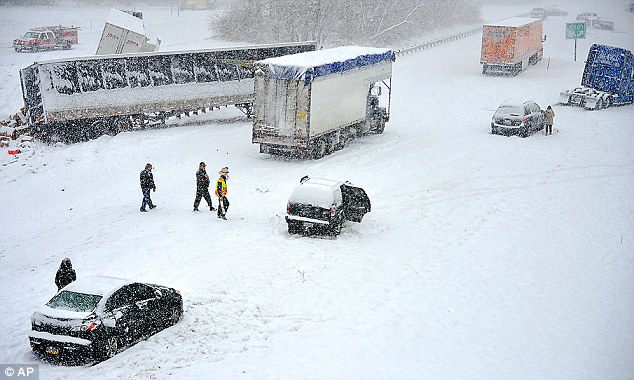The U.S. economy has stalled amid a winter freeze but the Federal Reserve is unlikely to act because warmer weather should bring a rebound, leading to higher U.S. stock prices and tighter credit spreads.
by Scott Minerd, Global CIO, Guggenheim Partners LLC
Last week we correctly forecast that U.S. retail sales would be heavily hit by the cold snap. Since then, there has been a litany of weather-related bad news -- U.S. industrial production has decreased, mortgage applications have fallen, housing data disappointed, and even restaurants are struggling. The full extent of the weakness may have surprised many, but investors often underestimate the ripple effects of a supply chain interruption. This environment is evocative of Japan’s 2011 earthquake and tsunami, which threw the global supply chain into such disarray that it caused an 11 percent decline in U.S. auto sales in the middle of that year.
Economic weakness may lead some investors to think the Federal Reserve might act, but policymakers are unlikely to alter their current tapering course based on short-term economic swings. Nevertheless, in the coming weeks, market jitters could push 10-year U.S. Treasury yields lower as it becomes apparent just how badly the economy has stalled.
The good news is that this is likely only transient noise, and that rising temperatures in March and April should revive everything from auto sales to factory activity, helping the U.S. economy return to its improving trend. Pent-up consumer demand should re-accelerate growth in the spring after this short, sharp pain, setting the United States on course for solid growth in 2014 of 3.5 percent or more.
Given underlying economic strength, the recent upside breakout of the New York Stock Exchange’s Advance/Decline Line adds to expectations that U.S. equity prices will continue rising over the next three to six months and that U.S. bond spreads should tighten further.
Chart of the Week
U.S. Rebound Likely After Weather-Depressed January
Economic data for January continues showing the negative effect of unusually cold weather in much of the United States. However, the weak data is likely temporary, and should reverse once weather returns to more normal patterns. Based on past experiences where cold weather depressed retail sales in January, there could be a meaningful rebound in consumer activity in the coming months as pent-up demand is released.
RETAIL SALES, LEVEL IN DECEMBER=100

Source: Haver, Guggenheim Investments. Data as of 1/31/2014. *Note: Severe winters have Januaries in which the deviation of heating degree days (a measure of temperature) plus the deviation of precipitation is greater than 10 percent and retail sales are negative – something that has occurred five times since 1978.
Economic Data Releases
Cold, Snow in Much of the United States Still Working Through Data
- Retail sales were much lower-than-expected, dropping 0.4 percent vs. a consensus forecast of 0.0 percent. The broad-based decrease was led by declining auto and department store sales.
- Industrial production dropped 0.3 percent in January, an unexpected decrease and the first since July. A large cold weather-induced increase in utilities was not enough to offset sinking manufacturing production.
- Housing starts plunged 16 percent in January to 880,000, the largest decline since February 2011. Though weather factors may be partly to blame, starts in the Northeast surged 62 percent from December.
- The NAHB Housing Market Index declined for a second consecutive month in February, falling from 56 to 46, the lowest level since May 2013.
- University of Michigan consumer confidence was unchanged in February from January at 81.2, as more upbeat expectations were weighed down by slightly worsening views of current conditions.
- Regional Fed indices showed larger than expected declines, with the Empire Manufacturing Index down and the Philadelphia Fed survey falling to a one-year low.
- The U.S. CPI remained muted in January, rising only slightly to 1.6 percent year-over-year. Rising energy costs were the largest contributors to the gain.
- The Leading Economic Index rose 0.3 percent in January, with five of the 10 indicators increasing. Strong financial indicators and lower jobless claims were partially offset by a drop in building permits and hours worked.
Euro Zone Data Falters After Fourth Quarter Growth, Japan GDP Disappoints
- Fourth quarter GDP figures were encouraging across the euro zone, with German output up 0.4 percent from the third quarter and French GDP climbing 0.3 percent. For the euro zone as a whole, GDP rose 0.3 percent, the third consecutive quarter of expansion.
- The ZEW survey of investor expectations in Germany dropped to 55.7 in February, the largest one-month decrease since last April.
- Manufacturing PMIs across the euro zone fell slightly in February, with the euro zone PMI decreasing 1.0 to 53.0.
- Euro zone services PMIs were mixed, with the French PMI dropping to the lowest since last May while Germany’s rose to 55.4 after falling for two months.
- Euro zone consumer confidence unexpectedly worsened in February to -12.7, only the second decrease in the past year.
- China’s advance HSBC manufacturing PMI was lower than expected, showing a faster pace of contraction in February at 48.3. The drop contrasts with strong trade and credit figures published last week.
- Fourth quarter GDP disappointed in Japan, rising just 1.0 percent on an annualized basis, the worst quarter of 2013. A large increase in imports weighed on the figure.













